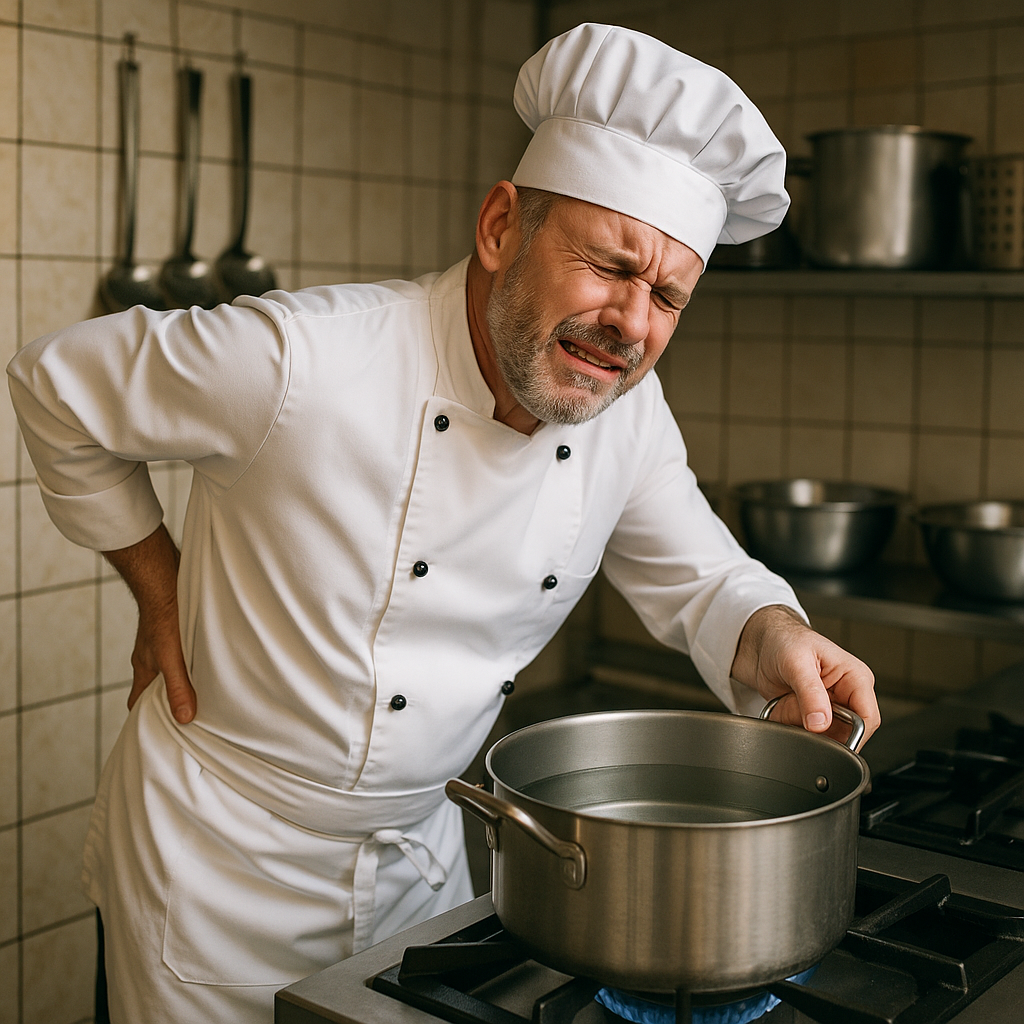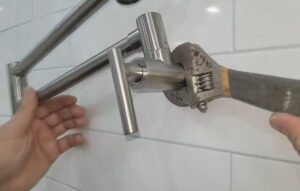Busy cooking sessions often involve repetitive movements, extended standing periods, and frequent lifting of heavy, liquid-filled pots. Carrying a pot containing five liters of water adds roughly five kilograms of weight—plus the mass of the pot itself—across the kitchen floor. Over time, these repeated lifts and carries place cumulative load on the lumbar spine, hips, knees and shoulders. In professional settings, chief cooks report a lifetime prevalence of low back pain (LBP) as high as 79.2 percent, compared with 30 percent among kitchen aids, highlighting the elevated risk among those tasked with handling the largest loads (researchgate.net). Globally, occupational ergonomic factors such as heavy lifting and awkward postures accounted for approximately 14.17 million person-years lost to disability due to LBP in 2021—and projections indicate this will surpass 15 million person-years by 2037 (frontiersin.org). Mitigating these risks is essential to preserving mobility, productivity and long-term health.
Biomechanics of Lifting and Repetitive Loads

When a cook lifts a pot at or below waist height, the shoulders counterbalance the mass, while the spinal extensors maintain an upright torso. A typical 4 L pot of water plus pot weighs roughly 6 kg; lifting it from counter to stovetop three times per cooking session can exert forces on the lower back well above recommended safety thresholds. Static holds—such as pausing mid-carry—amplify compressive load on intervertebral discs, and rapid transitions between bent and upright postures increase shear forces on lumbar vertebrae. In domestic or commercial kitchens, cooks stand for hours and perform stooping, twisting and lifting dozens of times each hour. This combination of static and dynamic loading accelerates tissue fatigue in muscles, ligaments and joints, paving the way for micro-tears, inflammation and chronic pain (mtpinnacle.com).
Key Risk Factors
-
Load magnitude: Higher pot volume directly increases musculoskeletal stress.
-
Repetition: Frequent lifts without breaks lead to cumulative strain.
-
Posture: Twisting or bending while carrying heightens risk of disc injury.
-
Duration: Extended standing and static holds reduce blood flow and recovery.
-
Age and experience: Older cooks or those with longer tenure face elevated prevalence of LBP (mdpi.com).
Ergonomic Principles for Kitchen Tasks
Ergonomics aims to align tasks, tools and environments with human capabilities. In the kitchen context, the goal is to design workflows and install equipment that reduce awkward postures, high forces and repetition. The Occupational Safety and Health Administration (OSHA) recommends substituting elevated faucets or hoses for manual lifting of liquid loads:
“Use an elevated faucet or hose to fill large pots. Avoid lifting heavy pots filled with liquids” (osha.gov).
Physical therapists reinforce this approach. Wanda K. Evans PT, DPT writes that “Physical therapists can apply ergonomic principles to assess workflow and recommend modifications to decrease injuries from repetitive motions and heavy lifting” (apta.org). By minimizing the need to hoist water-laden pots, cooks preserve joint integrity and reduce muscular fatigue.
Wall-Mount Pot Fillers: A Targeted Solution
A wall-mount pot filler is a specialized faucet installed above the cooktop, connected directly to the home’s plumbing. It folds flat against the backsplash when not in use and extends over the burners as needed. This strategic placement eliminates the most hazardous lift: carrying heavy water from sink to stove.
Functional Advantages
-
Elimination of heavy lifting: Pots can be filled in place, bypassing the need to carry 15–30 lb loads across the kitchen floor (premierhomes.group).
-
Spill reduction: Direct filling reduces drop height and sloshing, curbing slip hazards and cleanup time.
-
Streamlined workflow: Multiple pots on different burners can be refilled quickly without interrupting cooking flow.
Valerie Ann Helgeson, founder of Design Directions, notes that “A typical stockpot can weigh anywhere from 16 to 33 pounds, and walking a sloshing pot across the kitchen isn’t ideal” (marthastewart.com). Installing a pot filler thus addresses both safety and efficiency in one measure.
Planning and Installation Considerations
Proper planning ensures that a wall-mount pot filler delivers its intended benefits without introducing new issues.
-
Placement height: Industry guidance indicates a vertical clearance of 16–24 inches above the cooktop, measured from burner grate to spout when folded in, to accommodate pot heights and handles (thespruce.com).
-
Plumbing access: Most kitchens lack water lines behind the range. A licensed plumber must run new lines within the wall cavity, ensuring compliance with local codes and preventing leaks.
-
Structural support: The wall behind the stove must feature reinforced backing or a mounting block to bear the weight and torque of the articulated arm.
-
Clearance for heat and backsplash materials: Heat-resistant surfaces prevent damage to the pot filler body and ensure longevity.
A typical installation cost ranges from €260 to €3 200, depending on the complexity of rerouting plumbing and any wall modifications (thespruce.com). Though not negligible, this investment may pay dividends in reduced injury risk and improved cooking experience.
Cost-Benefit Analysis
When evaluating the return on investment, homeowners and chefs should balance upfront expenses against long-term health and productivity gains.
| Expense Category | Estimated Range |
|---|---|
| Pot filler unit | €150–€800 |
| Professional plumbing | €200–€1 500 |
| Wall reinforcement | €50–€400 |
| Total typical cost | €400–€2 700 |
Health savings: With LBP accounting for over 83 percent of lower back discomfort among workers handling heavy loads often (bmcmusculoskeletdisord.biomedcentral.com), reducing a single high-risk task can lower likelihood of chronic pain and related healthcare costs.
Productivity gains: Chefs save minutes per batch of water filled, leading to aggregate time savings of up to 10 percent in water-intensive recipes. Over a year, this equates to dozens of hours reclaimed for prep and plating.
Resale impact: A pot filler can contribute to a perception of a thoughtfully designed, ergonomic kitchen. Luxury home markets report a 50 percent surge in “pot filler tap” searches over the past year (architecturaldigest.com), suggesting growing buyer appeal.
Maintenance and Usage Best Practices
To ensure sustained benefits and avoid complications:
-
Regular cleaning: Wipe down the spout arm and joints weekly to prevent grease buildup from stovetop splatter.
-
Annual inspection: Have a plumber check seals and mounting hardware each year to detect leaks early.
-
Proper stowage: Retract the faucet arm fully against the backsplash when idle to minimize exposure to heat and knocks.
-
Temperature control: Use single-temperature pot fillers or mix hot and cold judiciously to reduce thermal cycling stress on valve components.
These measures guard against malfunction and keep the pot filler reliably at hand when the next boiling task calls.
Actionable Recommendations
-
Assess current strain: Track frequency and weight of pot lifts in typical cooking sessions to quantify ergonomic exposure.
-
Consult an ergonomist or physical therapist: Obtain an on-site assessment of kitchen workflow and posture, with recommendations tailored to individual stature and cooking routines.
-
Obtain multiple quotes: Solicit bids from at least two licensed plumbers for pot filler installation, ensuring they include wall reinforcement and code-compliance work.
-
Schedule installation during remodel: Coordinate pot filler plumbing with any planned kitchen updates to minimize disruption and save on labor costs.
-
Train kitchen staff or household members: Educate on safe use, stowage procedures and simple maintenance checks to foster longevity of the fixture.
By systematically addressing the mechanical, procedural and maintenance dimensions, cooks can substantially mitigate back and joint strain—and redirect focus to the culinary creations themselves.
Broader Implications for Kitchen Ergonomics
While pot fillers tackle a single, high-impact hazard, comprehensive kitchen ergonomics encompasses workstation height, tool design, flooring surfaces and movement patterns. Employers and homeowners should view pot filler installation as part of a larger ergonomic strategy that includes:
-
Adjustable countertops to match cook height.
-
Anti-fatigue mats to reduce stress on feet, knees and hips.
-
Lightweight cookware with heat-resistant handles to ease grip forces.
-
Workflow zoning to minimize unnecessary steps between prep, cooking and plating areas.
When ergonomic principles guide kitchen design, the risk profile for LBP and joint disorders declines sharply. Given that two-thirds of adults report back pain in any one-month period (pmc.ncbi.nlm.nih.gov), preventive measures in the home kitchen offer both immediate comfort and long-term health dividends.
By integrating a wall-mount pot filler into a thoughtfully designed kitchen, both professionals and home cooks can eliminate the most hazardous manual lift: carrying water-filled pots. This targeted intervention, backed by ergonomic science and real-world data, streamlines cooking workflows, reduces injury risk and enhances overall kitchen functionality. Through diligent planning, proper installation and ongoing maintenance, the pot filler can serve as a cornerstone of a more resilient, user-friendly culinary environment—one where the focus returns squarely to the art and science of cooking, rather than the toll it exacts on the body.



